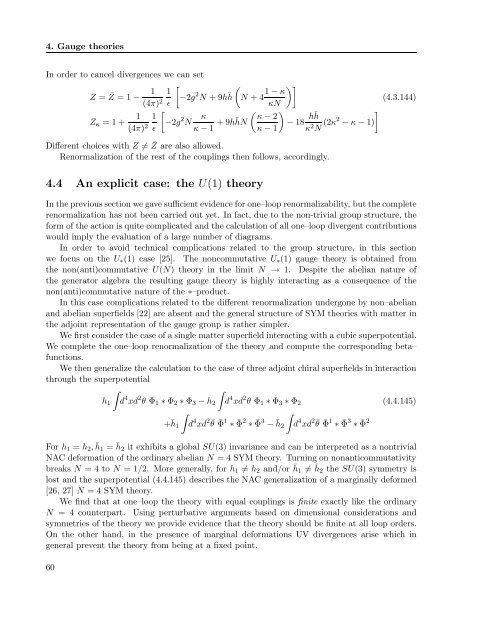Perturbative and non-perturbative infrared behavior of ...
Perturbative and non-perturbative infrared behavior of ...
Perturbative and non-perturbative infrared behavior of ...
Create successful ePaper yourself
Turn your PDF publications into a flip-book with our unique Google optimized e-Paper software.
4. Gauge theories<br />
In order to cancel divergences we can set<br />
Z = ¯ Z = 1 − 1<br />
(4π) 2<br />
<br />
1<br />
−2g<br />
ǫ<br />
2 N + 9h¯ <br />
1 − κ<br />
h N + 4 (4.3.144)<br />
κN<br />
Zκ = 1 + 1<br />
(4π) 2<br />
<br />
1<br />
−2g<br />
ǫ<br />
2 N κ<br />
κ − 1 + 9h¯ <br />
κ − 2<br />
hN − 18<br />
κ − 1<br />
h¯ h<br />
κ2N (2κ2 <br />
− κ − 1)<br />
Different choices with Z = ¯ Z are also allowed.<br />
Renormalization <strong>of</strong> the rest <strong>of</strong> the couplings then follows, accordingly.<br />
4.4 An explicit case: the U(1) theory<br />
In the previous section we gave sufficient evidence for one–loop renormalizability, but the complete<br />
renormalization has not been carried out yet. In fact, due to the <strong>non</strong>-trivial group structure, the<br />
form <strong>of</strong> the action is quite complicated <strong>and</strong> the calculation <strong>of</strong> all one–loop divergent contributions<br />
would imply the evaluation <strong>of</strong> a large number <strong>of</strong> diagrams.<br />
In order to avoid technical complications related to the group structure, in this section<br />
we focus on the U∗(1) case [25]. The <strong>non</strong>commutative U∗(1) gauge theory is obtained from<br />
the <strong>non</strong>(anti)commutative U(N) theory in the limit N → 1. Despite the abelian nature <strong>of</strong><br />
the generator algebra the resulting gauge theory is highly interacting as a consequence <strong>of</strong> the<br />
<strong>non</strong>(anti)commutative nature <strong>of</strong> the ∗–product.<br />
In this case complications related to the different renormalization undergone by <strong>non</strong>–abelian<br />
<strong>and</strong> abelian superfields [22] are absent <strong>and</strong> the general structure <strong>of</strong> SYM theories with matter in<br />
the adjoint representation <strong>of</strong> the gauge group is rather simpler.<br />
We first consider the case <strong>of</strong> a single matter superfield interacting with a cubic superpotential.<br />
We complete the one–loop renormalization <strong>of</strong> the theory <strong>and</strong> compute the corresponding beta–<br />
functions.<br />
We then generalize the calculation to the case <strong>of</strong> three adjoint chiral superfields in interaction<br />
through the superpotential<br />
<br />
h1 d 4 xd 2 <br />
θ Φ1 ∗ Φ2 ∗ Φ3 − h2 d 4 xd 2 θ Φ1 ∗ Φ3 ∗ Φ2<br />
(4.4.145)<br />
+ ¯ <br />
h1 d 4 xd 2¯<br />
<br />
θ Φ¯ 1<br />
∗ Φ¯ 2<br />
∗ Φ¯ 3<br />
− h2<br />
¯ d 4 xd 2¯ θ Φ¯ 1<br />
∗ Φ¯ 3<br />
∗ Φ¯ 2<br />
For h1 = h2, ¯ h1 = ¯ h2 it exhibits a global SU(3) invariance <strong>and</strong> can be interpreted as a <strong>non</strong>trivial<br />
NAC deformation <strong>of</strong> the ordinary abelian N = 4 SYM theory. Turning on <strong>non</strong>anticommutativity<br />
breaks N = 4 to N = 1/2. More generally, for h1 = h2 <strong>and</strong>/or ¯ h1 = ¯ h2 the SU(3) symmetry is<br />
lost <strong>and</strong> the superpotential (4.4.145) describes the NAC generalization <strong>of</strong> a marginally deformed<br />
[26, 27] N = 4 SYM theory.<br />
We find that at one–loop the theory with equal couplings is finite exactly like the ordinary<br />
N = 4 counterpart. Using <strong>perturbative</strong> arguments based on dimensional considerations <strong>and</strong><br />
symmetries <strong>of</strong> the theory we provide evidence that the theory should be finite at all loop orders.<br />
On the other h<strong>and</strong>, in the presence <strong>of</strong> marginal deformations UV divergences arise which in<br />
general prevent the theory from being at a fixed point.<br />
60
















